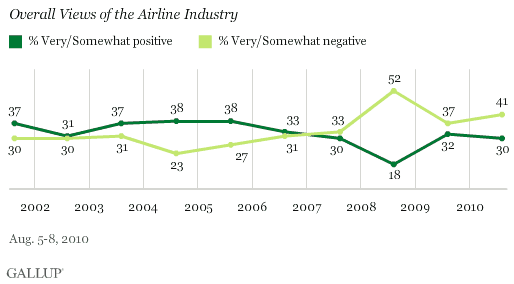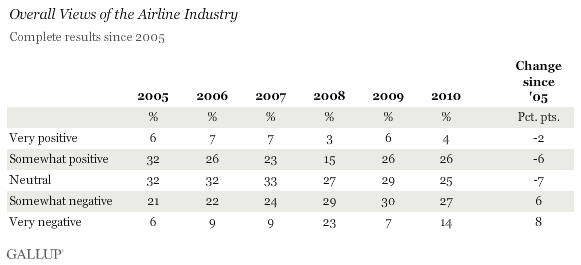WASHINGTON, D.C. -- Americans' general displeasure with the airline industry continues for a fourth straight year, with 41% viewing it negatively and 30% viewing it positively.

The findings are from an Aug. 5-8 Gallup poll that asked Americans to rate 25 business and industry sectors. The airline industry's net positive rating of -11 puts it toward the bottom of the pack.
Americans have been lukewarm on the airline industry since Gallup began measuring opinions about major U.S. industries in 2001. Despite the security and financial challenges that followed the terrorist attacks of Sept. 11, 2001, airlines managed a slightly more positive than negative image from 2003 to 2007, when Americans became more negative than positive.
The sharp rise in negativity in 2008 likely stemmed from higher airfares put in place amid high gas prices and the worsening U.S. recession at the time. Airfares remain high on a relative basis, with reports this week that they are as much as 20% higher than they were a year ago, and are climbing. What's more, the additional fees imposed by airlines have proven highly unpopular. As recently as January of this year, 76% of Americans who had flown at least twice in the past year said they were dissatisfied with the fees charged for checking baggage and rebooking flights. This was far more than were dissatisfied with the procedures for going through security, the price they paid for tickets, and airlines' efforts to deal with delays and cancellations.
In this climate, 14% of Americans say their views of the airline industry are "very negative," more than said so a year ago, but less than the 23% who said so in 2008. Overall, Americans have become less neutral and more negative on the industry since 2005.

The International Air Transport Association reported Wednesday that U.S. airlines are set to post $2.5 billion in profits in 2010, after having lost $9.9 billion in 2009. With overall demand up only slightly, the projection suggests that airlines' efforts to boost revenues are paying off in their own bottom lines. Still, the Gallup data indicate the additional cost of flying, amid depressed economic confidence and consumer spending, have likely helped keep Americans' ratings of airline industries more negative than positive. Airlines should be mindful of these perceptions, and the balance between cost and quality of service, as they seek to re-enter positive territory, both financially and in Americans' eyes.
Results for this Gallup poll are based on telephone interviews conducted Aug. 5-8, 2010, with a random sample of 1,013 adults, aged 18 and older, living in the continental U.S., selected using random-digit-dial sampling. Industry rating results are based on a half sample of 508 adults, for which the maximum margin of sampling error is ±5 percentage points.
Interviews are conducted with respondents on landline telephones (for respondents with a landline telephone) and cellular phones (for respondents who are cell phone-only). Each sample includes a minimum quota of 150 cell phone-only respondents and 850 landline respondents, with additional minimum quotas among landline respondents for gender within region. Landline respondents are chosen at random within each household on the basis of which member had the most recent birthday.
Samples are weighted by gender, age, race, education, region, and phone lines. Demographic weighting targets are based on the March 2009 Current Population Survey figures for the aged 18 and older non-institutionalized population living in continental U.S. telephone households. All reported margins of sampling error include the computed design effects for weighting and sample design.
In addition to sampling error, question wording and practical difficulties in conducting surveys can introduce error or bias into the findings of public opinion polls.
View methodology, full question results, and trend data.
For more details on Gallup's polling methodology, visit www.gallup.com.
